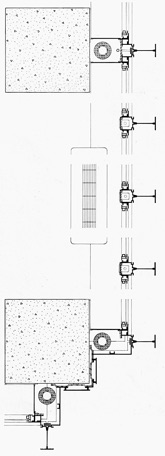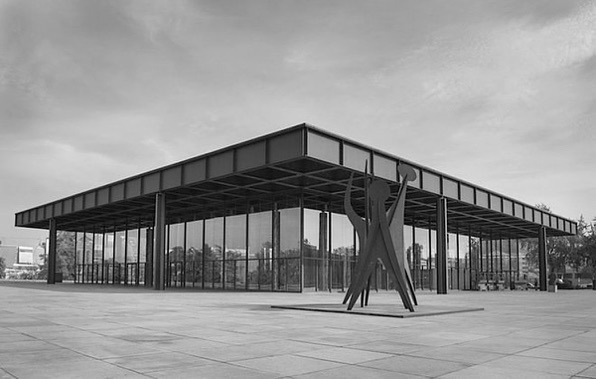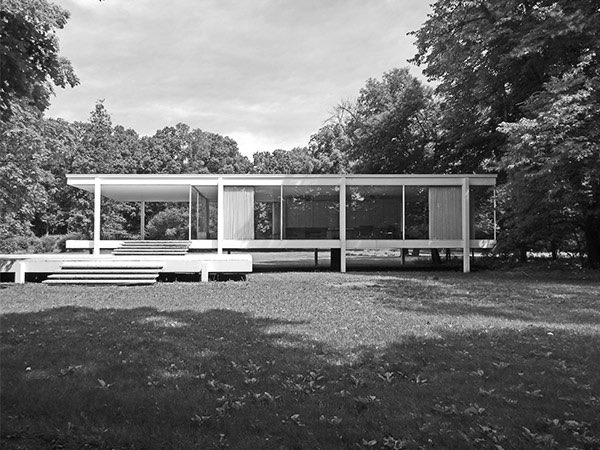



One must be careful in connecting philosophical ideas to architecture or any creative endeavor because its effect is to justify the work simply by association with “serious” thought. It is like background music in a movie. We are seduced into a more significant and legitimate interpretation of the experience, if it is accompanied by a serious and grand theme. Philosophy is just another form of myth in the sense that, it structures and tries to explain our view of reality.
Some may doubt that Mies would have advocated the themes suggested here, and perhaps it is a case of eyes that see too much in too little. (The notorious conundrum about the “presence of absence.”)
Nevertheless, the hypothesis is consistent with his work and is by itself uncritical. It proposes only that there was an evolving struggle to demonstrate the philosophy of Thomism, which was modified by a response to the important contemporary spiritual crisis of a more existential self. This formed the imperative conviction for Mies’s abstracted isolation of certain aspects of architecture and generated his particular minimal style.
In addition, this speculative examination of Mies’s work reveals a basic opposition of values within the modern movement, an opposition which establishes its own mutual critique. The argument of aesthetics and existentialism opposed to the argument of metaphysics and mysticism.
So, it is worth quoting and returning here to Ortega y Gasset with his parallel position to Mies’s architecture, while also providing its own self critique. To deemphasize the materiality of architecture is the same as to deemphasize the human subject in art. Both attempt to strip away (abstract) the clutter of familiar reality (representation) from the act of perception (and contemplation) in order to reach the essence of idea itself. Truth resides with the observer (who is a particularly unique modern person) if new forms are created pure enough to facilitate an intense, unique new mode of perception. This advocates that an essential authenticity of being can be found through the reduction of both form and content.
Ortega’s description of this process in art could easily be about Mies’s architecture:
-
“If turning our back on alleged reality, we take ideas for what they are — mere subjective patterns — and make them live as such, lean and angular, but pure and transparent”; in short if we deliberately propose to realize our ideas — “then we have to dehumanize them.”
-
“For ideas are really unreal. To regard them as reality is an idealization, a candid falsification. On the other hand, making them live in their very unreality is — let us express it this way — realizing the unreal as such.”
Which is the argument that meaning resides only in existence and appearances:
-
“In this way we do not move from the mind to the world. On the contrary, we give three-dimensional being to mere patterns, we objectify the subjective, we ‘worldify’ the immanent.”
To “worldify” the immanent was a “modern” aspiration to which Mies did aspire. It is particularly apparent in his empty, voided architectural space. To achieve this awareness, Ortega y Gasset seems to argue that it would be necessary to dematerialize architecture and that, this would also dehumanize it, in the modern drive toward a deep significance manifest in analytical abstraction.
On the other hand, following this view, the significance and effectiveness of the ideas now being “worldified” in architecture, there remains a critical question. It may be that our feelings today in looking at these two theoretical positions in modern architecture AND art are not unlike Mies’s reflection on his own situation in 1910:
-
“We young architects find ourselves in painful inner discord. Our enthusiastic hearts demand the unqualified, and we are ready to pledge ourselves to an idea. But the potential vitality of the architectural idea of the period has by this time been lost.”
-
14)The New National Gallery, Berlin, Germany, 1968
-
*Photo: Gili Merin
The same abstraction of site occurs in the 50 X 50 House where the structure is further reduced to only four columns. Each one is improbably centered on the side of a flat square roof. The roof itself, a thin space frame, becomes the only material element of the architecture (figure 13).
The term “space frame” itself is suggestive and perhaps carried some significance for Mies in the context of his philosophical values. The space frame’s vertical supports can be reduced to a minimum and the structural form of the ceiling, when exposed, produces a square grid expressed in steel.
But perhaps more accurately, it is the structure of a universal and infinite space. For how much architecture was left? What is finally manifest from the complex partitioning of a 3-bedroom house with bathrooms and toilets, etc.? There is an almost complete lack of substance and materiality, it is empty, a piece of the void deliberately created.
The 50 X 50 house established the basic conceptual model for the projects and buildings that followed it, leading through the first Bacardi Building project, finally to the realized Berlin Museum (figure 14). The “column-free” space, epitomized in the 50 X 50 house with its complete dematerialized form, remained the architectural paradigm of Mies’s metaphysical premise.
- - -
-
13)50 x 50 House, plan and rendering, 1951
*Rendering by: Luciana Fornari Colombo.
Despite the dramatic exterior girders, all structure disappears inside Crown Hall where the acoustic tile ceiling dominates as it hangs mysteriously without support.
The interior is, in a sense, unreal; empty, intangible, infinite space of calm contemplation, cut off from the outside world by translucent glass panels.
The placement of all the “facts” — columns, mullions and girders — on the outside of the building leaves all apparent structure obscured from the inside, emphasizing only the space itself as a neutral, dematerialized ideal condition of an empty void. Standing on the floor beneath the “floating” roof, there is the sense of being in an abstracted, purified, and detached world which is both disconcerting and mesmerizing.
This fascination with “column-free” space, begun at Crown Hall, was to preoccupy Mies for the rest of his career. His continued development of this idea leads to the approaching limit of a minimal reduced vocabulary and toward a more dematerialized architecture.
Following Crown Hall, in the Farnsworth House (figure 12), a single column-free unit of space is raised above the ground, literally detaching the architecture from the reality of gravity and specific place, further abstracting the dialogue between facts and ideas. Stripping everything down to the presentation of “being in essence.” A pure free pavilion hovering above reality.
There is no mass, no aggregate single form, just independent parts, elegantly assembled and defying gravity. The whole building is an abstraction of geometry, space, and by-passing pieces. It does not even establish a fixed relationship to the site. The building could be anywhere, a few feet closer to the road or a mile down the river. Perhaps there really is no site! It is certainly not incorporated into the scheme. It has been removed from consideration.
-
12)Farnsworth House, a Weekend House on the Fox River, Illinois,1950
-
11)Crown Hall, IIT Architecture School Building, 1956
Finally, with Crown Hall and 860-880 Lake Shore Drive, the brick wall disappears altogether from Mies’s vocabulary except as interior partition. From its early reality as a multiple condition of enclosure, structure, and formal element, the brick masonry is consistently transformed in terms of this metaphysical hypothesis of the abstraction and dematerialization of form.
Mies progressively isolates the masonry’s attributes until at IIT it is no longer a plastic object or an impenetrable boundary frame, but becomes virtually “transparent,” simultaneously inscribed and penetrated by the grid. From this point on brick is not used; Mies dematerializes the architecture further by reducing the facts to just steel, glass and space.
The apartment buildings at 860-880 Lake Shore Drive were the important transition from the IIT type to the ultimate development of Mies’s minimal style, as a comparative examination of the horizontal plan details of the Chemistry Building and 860-880 reveals the subtlety of the transition. The details are in fact almost identical except for the removal of the IIT bricks at 860-880. In both, the “I-beam” mullions are laid directly on the structural surface, maintaining their constant rhythm between and across the columns (figures 9,10).
The earliest wall of Alumni Memorial Hall at IIT does not expose the structure. Instead, a regular frame of mullions is applied to the outside surface. 860-880 Lakeshore Drive repeats this IIT building arrangement as mullions are applied to the outside front surface of the structure, but then deviates from IIT by moving the glass plane back directly onto the column surface, thus exposing the mullions as a solid visual element.
The result, although interestingly syncopated, requires an unjustified mullion on the column face. 900-910 Lakeshore Drive solves the problem by adding a gap between column face and screen wall, allowing the glass and the mullions to pass freely by the structure. As a result every window in the building is the same size and air conditioning runs are accommodated.
- - -
The difference at the 860-880 apartment slabs from the IIT buildings is that the plane of glass and spandrel are pushed to the back side of the “I-beams.” This decision shifts the reading of the facades back onto the flat structural surface, making it primary with the mullions then attached in front of it. Thus, there is a simultaneous emphasis on the larger rhythm of the structural frame and the absolutely regular steel mullion placement.
While one may lament the loss of this resulting contrapuntal richness in his later facades, starting with 900-910 Lakeshore Drive, Mies’s own values required that he suppress the structure again as he had done at IIT, in order to reassert the constancy and regularity of the abstract grid which had been lost at 860-880.
He was not interested in structural expression. It was necessary to remove the structure so that the facade could be more abstract and transparent as a representation of the significance he attached to the idea of continuous space ordered by pure geometry.
In 860-880 the interaction of structure, mullions, and windows overemphasizes the building’s presence as a complex material artifact, with its real form too clearly established by the continuous surface of encased columns and beams. A return to the de-emphasis of the structural frame was achieved at the Commonwealth Promenade Apartments across the street at 900-910 Lake Shore Drive, by interposing a layer of space between the column and the back of the mullion. Once resolved, this detail separating structure from building edge remained the constant solution for all Mies’s remaining high-rise buildings, because he believed it was the right solution to a larger question. This constancy in itself is an indication of his quest for a singular philosophical clarity.
-
“I don’t want to be interesting; I want to be good.”
Even Crown Hall, with its apparent structural expression, can be seen as an attempt to remove “real” structure from our perception of its tangible role of support. The repetitive gridded frame itself is not used. The structure is removed from the interior of the main hall, so that the columns and beams seem applied outside the building box to produce a “column-free” neutral space. The columns are equated with the mullions, obscuring any differentiation of function with both made of “I-beam” sections placed on front of roof and floor edges. Every material element bypasses the other without apparently connecting to, or supporting anything. The front stairs seem to float and the roof girders seem to sit on the roof rather than hold it up (figure 11).
-
Three plan details that show how the screen wall that Mies placed in front of the column structure at IIT developed to become the separate curtain wall in his high-rise buildings.
-
9)Alumni Memorial Hall, IIT, Chicago, 1945
-
10)860-880 Lake Shore Drive, Chicago, 1951
-
10)900-910 Lake Shore Drive, Chicago, 1954



9
10
11
12

Peterson Littenberg Architecture and Urban Design 131 East 66th Street, New York, NY 10065 Telephone (212) 772-7114 Website by Architectural Webdesign Wind powered by MacHighway





